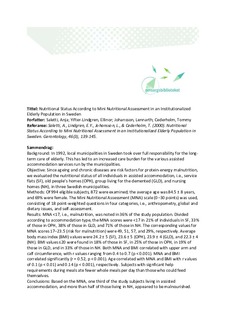| dc.identifier.citation | Saletti, A., Lindgren, E.Y., Johansson, L., & Cederholm, T. (2000). Nutritional Status According to Mini Nutritional Assessment in an Institutionalized Elderly Population in Sweden. Gerontology, 46(3), 139-145. | nb_NO |
| dc.description.abstract | Background: In 1992, local municipalities in Sweden took over full responsibility for the long-term care of elderly. This has led to an increased care burden for the various assisted accommodation services run by the municipalities.
Objective: Since ageing and chronic diseases are risk factors for protein-energy malnutrition, we evaluated the nutritional status of all individuals in assisted accommodation, i.e., service flats (SF), old people’s homes (OPH), group living for the demented (GLD), and nursing homes (NH), in three Swedish municipalities.
Methods: Of 994 eligible subjects, 872 were examined; the average age was 84.5 ± 8 years, and 69% were female. The Mini Nutritional Assessment (MNA) scale (0–30 points) was used, consisting of 18 point-weighted questions in four categories, i.e., anthropometry, global and dietary issues, and self-assessment.
Results: MNA <17, i.e., malnutrition, was noted in 36% of the study population. Divided according to accommodation type, the MNA scores were <17 in 21% of individuals in SF, 33% of those in OPH, 38% of those in GLD, and 71% of those in NH. The corresponding values for MNA scores 17–23.5 (risk for malnutrition) were 49, 51, 57, and 29%, respectively. Average body mass index (BMI) values were 24.2 ± 5 (SF), 23.6 ± 5 (OPH), 23.9 ± 4 (GLD), and 22.3 ± 4 (NH). BMI values ≤20 were found in 18% of those in SF, in 25% of those in OPH, in 19% of those in GLD, and in 33% of those in NH. Both MNA and BMI correlated with upper arm and calf circumference, with r values ranging from 0.4 to 0.7 (p < 0.001). MNA and BMI correlated significantly (r = 0.52, p < 0.001). Age correlated with MNA and BMI with r values of 0.1 (p < 0.01) and 0.14 (p < 0.001), respectively. Subjects with signficant help requirements during meals ate fewer whole meals per day than those who could feed themselves.
Conclusions: Based on the MNA, one third of the study subjects living in assisted accommodation, and more than half of those living in NH, appeared to be malnourished. Further studies are necessary to assess to what extent these nutritional disturbances are reversible. | nb_NO |
